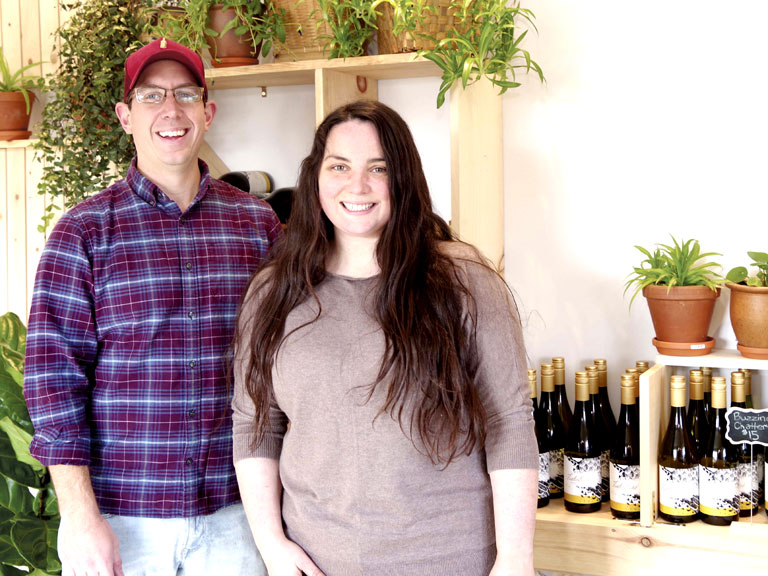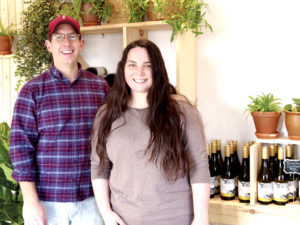County News
FieldBird flourishes

Production ramps up at FieldBird Cider
At the end of 2017, Ryan Monkman and his wife, Nicole, were justifiably proud to say they had made 15 barrels of cider. They had first visited the County in 2015 and literally within minutes decided they wanted to live here. They purchased a small farm on Danforth Road, with a plan to grow their own orchard in a 10-year time frame. In the meantime, they would source County apples and craft their cider in rented space at Keint-He winery. The young couple intended to operate a biodynamic orchard, following a holistic approach that had ethical, ecological and spiritual components, viewing the entire farm as a single living organism. But a serendipitous turn of events instead saw Ryan this past weekend staring into the face of what he jokingly calls “pearmageddon”— crates upon crates of pears waiting to be turned into juice for fermenting at their newly acquired farm on County Road 62, just north of Bloomfield.
Ryan had been obtaining fruit from Maw’s Orchards, and when the owners decided to sell late in 2018, he and Nicole leapt at the chance to take their cider business to the next level. They took over the farm right at pruning time, and they and their team started the biodynamic practice immediately. Each one of the thousands of fruit trees was examined and treated as part of the whole, taking into consideration the light it would receive and its relation to its neighbours. Now that he could control his own trees, Ryan could ensure the fruit was grown specifically for cider. “A commercial apple is grown to look really good on the shelf and taste really juicy when you bite into it,” he says. “Those things make it less desirable for cidermaking. It’s juicy because there’s lots of water, so we lose sugar concentration, flavour concentration and acid concentration, all the things we really want in a cider. Now we don’t irrigate, so the apples are drier and we get less juice, but the juice is better.” His goal now is not to grow a perfect looking apple, but instead grow a healthy tree.
“It’s okay if the apples have marks on them, as long as the tree itself is healthy.”

(L-R): Cider-makers Ryan Monkman and Amelia Keating-Isaksen in the FieldBird tasting room.
With a biodynamic farm, Ryan and Nicole only use plant-based products for pest and disease control. For instance, garlic oil is used to control mildew growing on the fruit, and a mint spray is used to repel insects. Keeping true to the principles of biodynamics, they will grow both garlic and mint on the farm for their own use, and they expect to be certified as a biodynamic farm in about three years. In the meantime they have this year’s harvest of apples and pears to process into cider. Ryan was trained as a winemaker, and he is using that approach to making cider. His co-cidermaker is Amelia Keating-Isaksen, who went through the training with him at Niagara College. “We’re processing fruit into juice, and because we work on what we call a vintage cycle, like a winery does, we need to go into fermentation and then aging,” says Ryan. “The next few months are going to be pretty crazy as we try to manage somewhere in the ball park of 60 different barrel ferments at once.”
The goal of Ryan and Amelia is to create ciders with a complex and diverse taste profile. “We’re trying to create a lot of diversity within the cellar, so each cider has some proportion of wild fermentation and some proportion of added yeast,” says Ryan. “The idea is to build up different populations of organisms and then blend them together for complexity layers. The alcoholic fermentation is fairly quick, but then we have the aging process and that could be anywhere from six months to three years in barrels.” All of their cider is fermented in barrels, and each barrel imparts a different characteristic to the cider. Most of their barrels are made from oak, but they do have a few of acacia, and a special few made of oak from the cider region in northern France. They will have approximately 120 barrels for this year’s vintage. “Every single barrel is treated different than all the other ones,” says Ryan. “Now it’s really hectic, and it’s about four to five hours a day tasting through every barrel and making sure things are okay. When fermentation is done, we have about 50 or 60 different elements we can play with when we start our blends.” Most of their cider is a classic still, dry cider, but they will be making some bubbly cider using the Champagne method. Some of this year’s harvest will be ready for drinking in May of next year, but they will leave some of the pear on lees for five years, and that will cider not be released until 2025.
While Ryan and Amelia take charge of the technical aspects of cidermaking, Ryan points out that the soul of the operation comes from Nicole. “Everything that you see here that looks really good, basically that’s Nicole,” he says, as he gestures around the tasting room. “She did the hand-drawn labels, and each vintage is a different bird. She designed the garden outside. I can run off and get too technical, but Nicole keeps it really centred, and pulls in the important parts and communicates that through art and design and storytelling. What makes this actually special is Nicole.”

Comments (0)